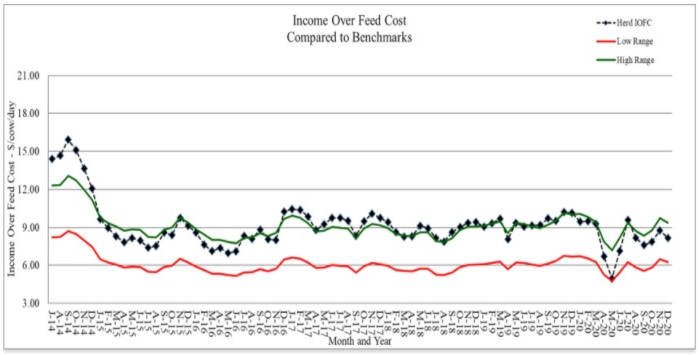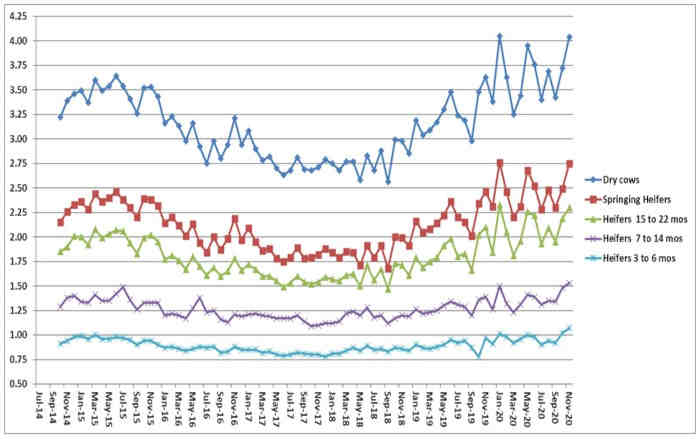By Virginia A. Ishler
Production perspective:
The current feed and milk market volatility can make one’s head spin. Grain and forage prices are rising, and this can negatively affect income over feed cost and the breakeven cost of production. Starch is a major nutrient in dairy rations, and it can also be expensive. There are some basic guidelines that are worth reviewing, especially when trying to keep feed costs under control and still optimize animal performance.
Of the cereal grains, corn is more widely fed, either as shelled or ear corn. The latter is comprised of 20 to 25% cob and 70 to 80% grain if partitioned by weight. The energy that cereal grains supply comes in the form of starch with minimal levels of fats and sugars. The availability and rate of digestion of the starch is heavily influenced by the processing method.
Starch in finely ground corn is degraded more rapidly by ruminal microorganisms than coarsely processed grain. Finely ground grains are higher in digestibility because there is more surface area to which the rumen bacteria can attach. The starch in high-moisture grains ferments more rapidly in the rumen than starch in dry grain. Heating grains, such as steam flaking (24 to 28 lbs./bu.), enhances starch digestion. The heating process gelatinizes the starch in a manner that increases fermentability in the rumen. Typically processing grains adds to their expense. The question to ask, “Is the processing really necessary to compliment the forage ration?”
Several factors should be considered when determining the ration starch level. These include forage particle size, frequency of grain feeding, site of starch digestion, fiber digestibility, use of by-product feeds, grain processing method, and dry matter intake. Figure 1 provides some guidelines for starch feeding.
Figure 1. Guideline for starch levels in lactating cow diets on a dry matter basis.
23-26% Barley, oats, high moisture grain, steam flaked grain, finely ground grain can predominate the concentrate portion of the diet.
27-29% High quality hay-crop forages predominate the ration and ingredients listed for the low starch levels are appropriate; corn silage predominates the ration and inclusion of non-forage fiber sources is appropriate.
>30% Coarsely processed corn is recommended coupled with non-forage fiber sources.
__________________________________________________________________________
There has been a trend over the past years to formulate for high starch levels that are also highly digestible. This approach has been common in heavy corn silage-based diets. However, herd dynamics such as long days in milk and number of first and second lactation animals can be negatively affected by high starch diets. Depressed milk components, reduced chewing activity, laminitis, inconsistent dry matter intake, and milk production not meeting the benchmarks for 2x and 3x milking (>75 and >85 pounds, respectively) may warrant reassessing the starch feeding strategy.
There have been several research papers published showing the positives of feeding a low starch diet. A lot depends on the forage base and other ingredients being fed. However, if animal performance is not meeting the minimum metrics on a high starch ration, then it may be time to consider an alternative approach. This adjustment could make a positive impact on income over feed cost during times of increasing grain prices.
Economic perspective:
Monitoring must include an economic component to determine if a management strategy is working or not. For the lactating cows, income over feed cost is a good way to check that feed costs are in line for the level of milk production. Starting with July 2014’s milk price, income over feed cost was calculated using average intake and production for the last six years from the Penn State dairy herd. The ration contained 63% forage consisting of corn silage, haylage and hay. The concentrate portion included corn grain, candy meal, sugar, canola meal, roasted soybeans, Optigen and a mineral vitamin mix. All market prices were used.
Also included are the feed costs for dry cows, springing heifers, pregnant heifers, and growing heifers. The rations reflect what has been fed to these animal groups at the Penn State dairy herd. All market prices were used.
Income over feed cost using standardized rations and production data from the Penn State dairy herd.

Note: December’s Penn State milk price: $18.61/cwt; feed cost/cow: $7.48; average milk production: 84 lbs.
Feed cost/non-lactating animal/day.

Source : psu.edu